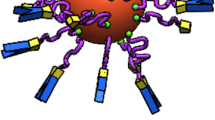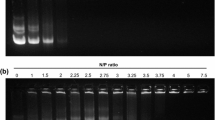Abstract
Recently, we have characterized the DNA and nucleoprotein (NP) binding of bis(4-N-methylpyridyl)-15,20-di(4-carboxyphenyl)porphyrin (BMPCP) and meso-tri(4-N-methylpyridyl)-mono(4-carboxyphenyl)porphyrin (TMPCP) and their tetrapeptide conjugates (BMPCP-4P2 and TMPCP-4P, respectively). In this work, we investigated the interaction of TMPCP conjugated to the tetrapeptide branches of branched chain polymeric polypeptide with poly-l-lysine backbone (AK) with DNA or NP using spectroscopic methods. Analysis of absorption spectra revealed the external binding but no intercalation of TMPCP-AK to DNA. There was no evidence for the interaction between TMPCP-AK and encapsidated DNA. Furthermore, we examined the cellular uptake of BMPCP and TMPCP and their tetra- or polypeptide conjugates by flow cytometry and analyzed how charge, size, and structure of the compounds affect their incorporation. In comparison, liposomal association constants of these derivatives were determined. BMPCP-4P2 accumulated the most, and porphyrins with two positive charges (BMPCP and BMPCP-4P2) showed better accumulation than the tri-cationic TMPCP or TMPCP-4P. Cellular uptake of polycationic TMPCP-AK was significantly lower than that of the free or tetrapeptide conjugated derivatives. The subcellular localization of all the five compounds was investigated in co-localization studies by confocal microscopy with special attention to their nuclear localization. Neither free nor conjugated BMPCP or TMPCP was co-localized with nuclear marker. Instead, these derivatives showed co-localization with lysosomal and mitochondrial fluorescent probes. TMPCP-AK conjugate had different localization patterns appearing mainly in mitochondria and cytoplasmic vesicles. Our results may contribute to the further design of DNA-targeting porphyrin-based constructs.










Similar content being viewed by others
References
Accetta A, Petrovic AG, Marchelli R, Berova N, Corradini R (2015) Structural studies on porphyrin-PNA conjugates in parallel PNA:PNA duplexes: effect of stacking interactions on helicity. Chirality 27:864–874. doi:10.1002/chir.22521
Angeli NG, Lagorio MG, San Román EA, Dicelio LE (2000) meso-substituted cationic porphyrins of biological interest. Photophysical and physicochemical properties in solution and bound to liposomes. Photochem Photobiol 72:49–56. doi:10.1562/0031-8655(2000)072<0049:MSCPOB>2.0.CO;2
Biron E, Voyer N (2008) Towards sequence selective DNA binding: design, synthesis and DNA binding studies of novel bis-porphyrin peptidic nanostructures. Org Biomol Chem 6:2507–2515. doi:10.1039/b803281e
Brault D, Vever-Bizet C, Le Doan T (1986) Spectrofluorimetric study of porphyrin incorporation into membrane models—evidence for pH effects. Biochim Biophys Acta 857:238–250. doi:10.1016/0005-2736(86)90352-4
Brown SB, Brown EA, Walker I (2004) The present and future role of photodynamic therapy in cancer treatment. Lancet Oncol 5:497–508. doi:10.1016/S1470-2045(04)01529-3
Clarke RJ, Appel H-J (1989) A stopped-flow kinetic study of the interaction of potential-sensitive oxonol dyes with lipid vesicles. Biophys Chem 34:225–237
Csik G, Egyeki M, Herenyi L, Majer Z, Toth K (2009) Role of structure-proteins in the porphyrin-DNA interaction. J Photochem Photobiol B: Biol 96:207–215. doi:10.1016/j.jphotobiol.2009.06.008
Dosselli R, Tampieri C, Ruiz-González R, De Munari S, Ragàs X, Sánchez-García D, Agut M, Nonell S, Reddi E, Gobbo M (2013) Synthesis, characterization, and photoinduced antibacterial activity of porphyrin-type photosensitizers conjugated to the antimicrobial peptide apidaecin 1b. J Med Chem 56:1052–1063. doi:10.1021/jm301509n
D’Urso A, Mammana A, Balaz M, Holmes AE, Berova N, Lauceri R, Purrello R (2009) Interactions of a tetraanionic porphyrin with DNA: from a Z-DNA sensor to a versatile supramolecular device. J Am Chem Soc 131:2046–2047. doi:10.1021/ja808099u
Estrada OS, Gitler C (1974) Perspectives in membrane biology. Academic Press, New York, pp 373–412
Ezzeddine R, Al-Banaw A, Tovmasyan A, Craik JD, Batinic-Haberle I, Benov LT (2013) Effect of molecular characteristics on cellular uptake, subcellular localization, and phototoxicity of Zn(2) N-alkylpyridylporphyrin. J Biol Chem 288:36579–36588. doi:10.1074/jbc.M113.511642
Gallagher R, Collins S, Trujillo J, McCredie K, Ahearn M, Tsai S, Metzgar R, Aulakh G, Ting R, Ruscetti F, Gallo R (1979) Characterization of the continuous, differentiating myeloid cell line (HL-60) from a patient with acute promyelocytic leukemia. Blood 54:713–733
Gong L, Bae I, Kim SK (2012) Effect of axial ligand on the binding mode of M-meso-tetrakis(N-methylpyridinium-4-yl)porphyrin to DNA probed by circular and linear dichroism spectroscopies. J Phys Chem B 116:12510–12521. doi:10.1021/jp3081063
Hudecz F (1995) Design of synthetic branched-chain polypeptides as carriers for bioactive molecules. Anticancer Drugs 6:171–193
Hudecz F, Szekerke M (1980) Investigation of drug-protein interactions and the drug-carrier concept by the use of branched polypeptides as model systems. Synthesis and characterisation of the model peptides. Collect Czech Chem Commun 45:933–940
Hudecz F, Votavov H, Gaál D, Sponar J, Kajtár J, Blaha K, Szekerke M (1985) Branched polypeptides with a poly(l-lysine) backbone: synthesis, conformation, and immunomodulation. In: Gebelein CG, Carraher CE (eds) Polymeric materials in medication. Plenum Press, New York, pp 265–289
Hudecz F, Clegg JA, Kajtár J, Embleton MJ, Pimm MV, Szekerke M, Baldwin RW (1993) Influence of carrier on biodistribution and in vitro cytotoxicity of methotrexate-branched polypeptide conjugates. Bioconjug Chem 4:25–33. doi:10.1021/bc00019a004
Jensen TJ, Vicente MGH, Luguya R, Norton J, Fronczek FR, Smith KM (2010) Effect of overall charge and charge distribution on cellular uptake, distribution and phototoxicity of cationic porphyrins in HEp2 cells. J Photochem Photobiol B Biol 100:100–111. doi:10.1016/j.jphotobiol.2010.05.007
Kapus A, Grinstein S, Wasan S, Kandasamy R, Orlowski J (1994) Functional characterization of three isoforms of the Na+/H+ exchanger stably expressed in Chinese hamster ovary cells. ATP dependence, osmotic sensitivity, and role in cell proliferation. J Biol Chem 269:23544–23552
Kessel D, Luguya R, Vicente MGH (2003) Localization and photodynamic efficacy of two cationic porphyrins varying in charge distribution. Photochem Photobiol 78:431–435. doi:10.1562/0031-8655(2003)078<0431:LAPEOT>2.0.CO;2
Lambrechts SAG, Aalders MCG, Langeveld-Klerks DH, Khayali Y, Lagerberg JWM (2004) Effect of monovalent and divalent cations on the photoinactivation of bacteria with meso-substituted cationic porphyrins. Photochem Photobiol 79:297–302. doi:10.1562/SA-03-15.1
Lee S, Jeon SH, Kim B-J, Han SW, Jang HG, Kim SK (2001) Classification of CD and absorption spectra in the Soret band of H2TMPyP bound to various synthetic polynucleotides. Biophys Chem 92:35–45. doi:10.1016/S0301-4622(01)00181-8
Madani F, Lindberg S, Langel Ü, Futaki S, Gräslund A (2011) Mechanisms of cellular uptake of cell-penetrating peptides. J Biophys. doi:10.1155/2011/414729 (article ID 414729)
Margalit R, Rotenberg M (1984) Thermodynamics of porphyrin dimerization in aqueous solutions. Biochem J 219:445–450
Mező G, Herényi L, Habdas J, Majer Z, Myśliwa-Kurdziel B, Tóth K, Csík G (2011) Syntheses and DNA binding of new cationic porphyrin-tetrapeptide conjugates. Biophys Chem 155:36–44. doi:10.1016/j.bpc.2011.02.007
Moret F, Gobbo M, Reddi E (2015) Conjugation of photosensitisers to antimicrobial peptides increases the efficiency of photodynamic therapy in cancer cells. Photochem Photobiol Sci 14:1238–1250. doi:10.1039/c5pp00038f
O’Connor AE, Gallagher WM, Byrne AT (2009) Porphyrin and nonporphyrin photosensitizers in oncology: preclinical and clinical advances in photodynamic therapy. Photochem Photobiol 85:1053–1074. doi:10.1111/j.1751-1097.2009.00585.x
Odeh AM, Craik JD, Ezzeddine R, Tovmasyan A, Batinic-Haberle I, Benov LT (2014) Targeting mitochondria by Zn(II)Nalkylpyridylporphyrins: the impact of compound sub-mitochondrial partition on cell respiration and overall photodynamic efficacy. PLoS One. doi:10.1371/journal.pone.0108238 (article number e108238)
Orosz Á, Csik G (2016) Peptide/protein conjugates of photosensitizers. In: Rzadnov M, Hudecz F (eds) Amino acids, peptides and proteins, vol 40. Royal Society of Chemistry, London, pp 100–145. doi:10.1039/9781782622680-00100
Orosz Á, Mezo G, Herényi L, Habdas J, Majer Z, Myśliwa-Kurdziel B, Tóth K, Csík G (2013) Binding of new cationic porphyrin-tetrapeptide conjugates to nucleoprotein complexes. Biophys Chem 177–178:14–23. doi:10.1016/j.bpc.2013.03.003
Pasternack RF, Gibbs EJ, Villafranca JJ (1983) Interactions of porphyrins with nucleic acids. Biochemistry 22:2406–2414
Pasternack RF, Bustamante C, Collings PJ, Giannetto A, Gibbs EJ (1993) Porphyrin assemblies on DNA as studied by a resonance light-scattering technique. J Am Chem Soc 115:5393–5399
Rajaputra P, Nkepang G, Watley R, You Y (2013) Synthesis and in vitro biological evaluation of lipophilic cation conjugated photosensitizers for targeting mitochondria. Bioorg Med Chem 21:379–387. doi:10.1016/j.bmc.2012.11.032
Ramos T (1983) Cell surface structures required for B-cell activation with haptenated syngeneic cells. J Immunol 17(411):417
Ricchelli F, Franchi L, Miotto G, Borsetto L, Gobbo S, Nikolov P, Bommer JC, Reddi E (2005) Meso-substituted tetra-cationic porphyrins photosensitize the death of human fibrosarcoma cells via lysosomal targeting. Int J Biochem Cell Biol 37:306–319. doi:10.1016/j.biocel.2004.06.013
Shui X, Peek ME, Lipscomb LA, Gao Q, Ogata C, Roques BP, Garbay-Jaureguiberry C, Wilkinson AP, Williams LD (2000) Effects of cationic charge on three-dimensional structures of intercalative complexes: structure of a bis-intercalated DNA complex solved by MAD phasing (review). Curr Med Chem 7:59–71
Sibrian-Vazquez M, Jensen TJ, Fronczek FR, Hammer RP, Vicente MGH (2005) Synthesis and characterization of positively charged porphyrin-pep tide conjugates. Bioconjug Chem 16:852–863. doi:10.1021/bc050057g
Sibrian-Vazquez M, Jensen TJ, Vicente MGH (2008) Synthesis, characterization, and metabolic stability of porphyrin-peptide conjugates bearing bifunctional signaling sequences. J Med Chem 51:2915–2923. doi:10.1021/jm701050j
Sibrian-Vazquez M, Jensen TJ, Vicente MGH (2010) Influence of the number and distribution of NLS peptides on the photosensitizing activity of multimeric porphyrin—NLS. Org Biomol Chem 8:1160–1172. doi:10.1039/b917280g
Soloway AH, Tjarks W, Barnum BA, Rong FG, Barth RF, Codogni IM, Wilson JG (1998) The chemistry of neutron capture therapy. Chem Rev 98:1515–1562
Strauss JH, Sinsheimer RLJ (1963) Purification and properties of bacteriophage MS2 and of its ribonucleic acids. Mol Biol 7:43–48
Szabó R, Sebestyén M, Gy Kóczán, Orosz Á, Mező G, Hudecz F (2017) Cellular uptake mechanism of cationic branched polypeptides with poly[l-Lys] backbone. Comb Sci (accepted for publication). doi:10.1021/acscombsci.6b00133
von Kleist S, Chany E, Burtin P, King M, Fogh J (1975) Immunohistology of the antigenic pattern of a continuous cell line from a human colon tumor. J Natl Cancer Inst 55:555–560
Wan MT, Lin JY (2014) Current evidence and applications of photodynamic therapy in dermatology. Clin Cosmet Investig Dermatol 7:145–163. doi:10.2147/CCID.S35334
Ziemssen F, Heimann H (2012) Evaluation of verteporfin pharmacokinetics redefining the need of photosensitizers in ophthalmology. Expert Opin Drug Met 8:1023–1041. doi:10.1517/17425255.2012.701617
Zupan Z, Herenyi L, Toth K, Majer Z, Csik G (2004) Binding of cationic porphyrin to isolated and encapsidated viral DNA Analyzed by comprehensive spectroscopic methods. Biochemistry 43:9151–9159. doi:10.1021/bi0495477
Acknowledgements
This work was supported by research grant Országos Tudományos Kutatási Alapprogramok (OTKA) K104045 and K104275.
Author information
Authors and Affiliations
Corresponding author
Ethics declarations
Conflict of interest
The authors declare that they have no conflict of interest.
Ethical approval
This article does not contain any studies with human participants or animals performed by any of the authors.
Additional information
Handling Editor: F. Albericio.
Rights and permissions
About this article
Cite this article
Orosz, Á., Bősze, S., Mező, G. et al. Oligo- and polypeptide conjugates of cationic porphyrins: binding, cellular uptake, and cellular localization. Amino Acids 49, 1263–1276 (2017). https://doi.org/10.1007/s00726-017-2428-z
Received:
Accepted:
Published:
Issue Date:
DOI: https://doi.org/10.1007/s00726-017-2428-z




